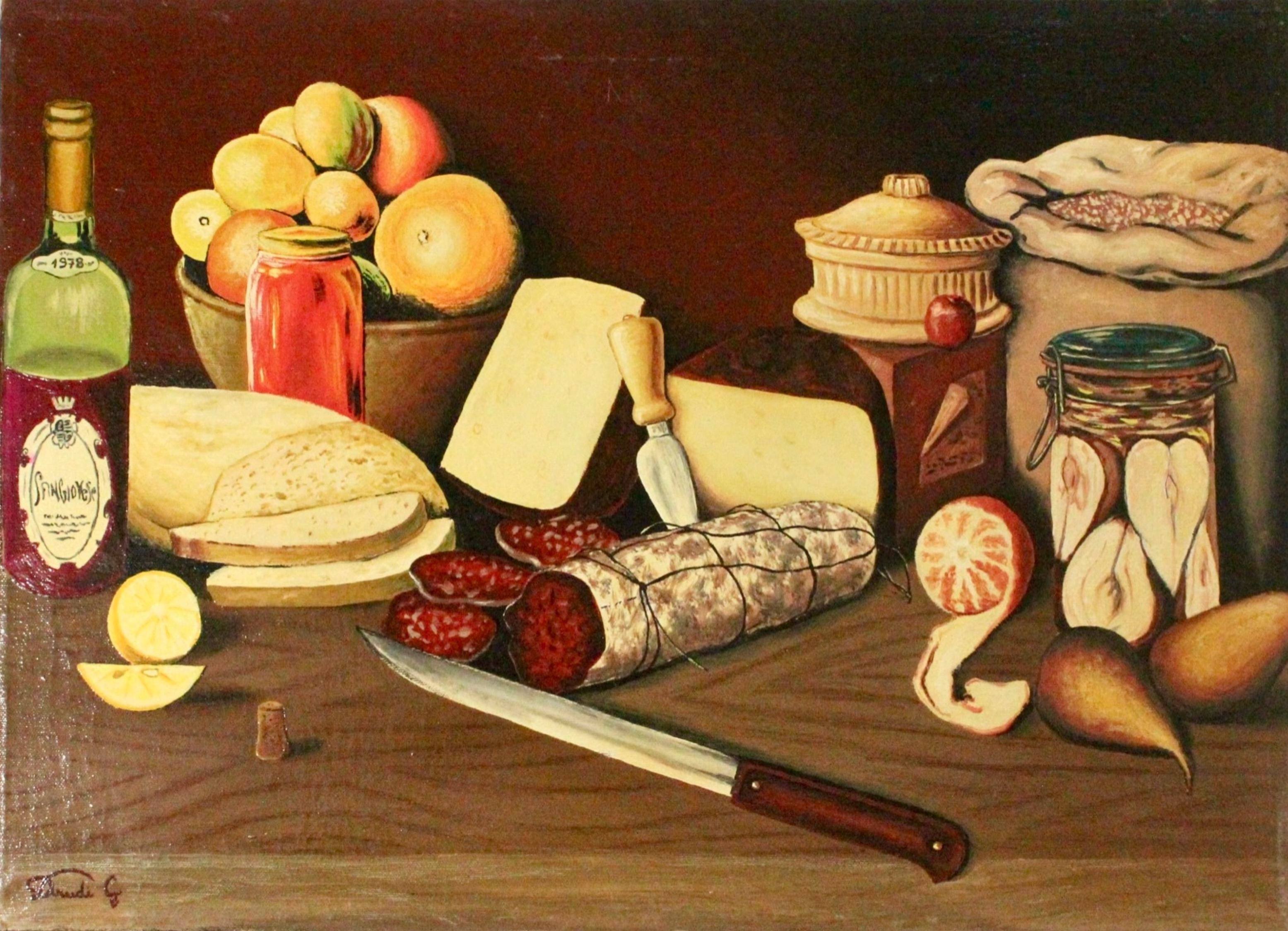STILL LIFE WITH SALAMI
1980, 50x70cm, Glossy oil on canvas

The painting represents many beautiful good things to eat, including homemade salami as it was made once. The vivid colors make the things represented in this painting seem real and tempt the observer to reach out almost to take them.
“Still Life with Salami,” created in 1980 with glossy oil on canvas, depicts with extraordinary mastery a rustic banquet rich in genuine products of the peasant tradition. The scene focuses on a laid table, where each element is painted with incredible realism. At the center of the composition stands out a homemade salami, carefully sliced, whose intense red contrasts harmoniously with the white of the fat, enhancing its texture. Next to it, a knife with a wooden handle, apparently just used, contributes to making the scene even more authentic.
Composition and details:
The cheeses, arranged with a variety of shapes and consistencies, suggest intense and genuine flavors, while the homemade bread, with its golden crust and soft crumb, seems to emanate an irresistible aroma. The bottle of Sangiovese wine from 1978, with its detailed label and the cork left on the table, suggests the convivial atmosphere of a meal just begun.
The fruit, citrus, and jars of jam and dried pears introduce a range of warm and natural colors, balancing the composition with harmony. The flour sack in the background recalls the craft of bread-making, connecting the scene to a tradition of hard work and passion. The use of glossy oil gives brilliance and depth to the colors, increasing the perception of realism and three-dimensionality.
Meaning and interpretation:
The work is not limited to representing a simple still life but becomes a celebration of rural life and the genuineness of traditional food. The artist, through the choice of elements and their arrangement, conveys a message of abundance, authenticity, and conviviality. The sliced salami, the poured wine, and the used knife suggest a lived moment, almost as if the scene had been interrupted for an instant before resuming the meal.
The foods are not just inanimate objects but tell stories of work, of expert hands that knead bread, of farmers who produce wine, and of a gastronomic culture rooted in tradition. The representation, so detailed and realistic, invites the viewer to reflect on the value of food, not only as nourishment but as an element of cultural identity and sharing.
Conclusion:
Overall, Still Life with Salami is a work that goes beyond the simple representation of a banquet, transforming into a tribute to tradition, simplicity, and the deep connection between food and culture. Through the skillful use of light, colors, and composition, the artist manages to convey the warmth and familiarity of a time when food was the fruit of work and passion. The scene invites the observer to immerse themselves in a world made of authentic flavors, conviviality, and memory, making the work a true tribute to the beauty of everyday life.

The painting represents many beautiful good things to eat, including homemade salami as it was made once. The vivid colors make the things represented in this painting seem real and tempt the observer to reach out almost to take them.
“Still Life with Salami,” created in 1980 with glossy oil on canvas, depicts with extraordinary mastery a rustic banquet rich in genuine products of the peasant tradition. The scene focuses on a laid table, where each element is painted with incredible realism. At the center of the composition stands out a homemade salami, carefully sliced, whose intense red contrasts harmoniously with the white of the fat, enhancing its texture. Next to it, a knife with a wooden handle, apparently just used, contributes to making the scene even more authentic.
Composition and details:
The cheeses, arranged with a variety of shapes and consistencies, suggest intense and genuine flavors, while the homemade bread, with its golden crust and soft crumb, seems to emanate an irresistible aroma. The bottle of Sangiovese wine from 1978, with its detailed label and the cork left on the table, suggests the convivial atmosphere of a meal just begun.
The fruit, citrus, and jars of jam and dried pears introduce a range of warm and natural colors, balancing the composition with harmony. The flour sack in the background recalls the craft of bread-making, connecting the scene to a tradition of hard work and passion. The use of glossy oil gives brilliance and depth to the colors, increasing the perception of realism and three-dimensionality.
Meaning and interpretation:
The work is not limited to representing a simple still life but becomes a celebration of rural life and the genuineness of traditional food. The artist, through the choice of elements and their arrangement, conveys a message of abundance, authenticity, and conviviality. The sliced salami, the poured wine, and the used knife suggest a lived moment, almost as if the scene had been interrupted for an instant before resuming the meal.
The foods are not just inanimate objects but tell stories of work, of expert hands that knead bread, of farmers who produce wine, and of a gastronomic culture rooted in tradition. The representation, so detailed and realistic, invites the viewer to reflect on the value of food, not only as nourishment but as an element of cultural identity and sharing.
Conclusion:
Overall, Still Life with Salami is a work that goes beyond the simple representation of a banquet, transforming into a tribute to tradition, simplicity, and the deep connection between food and culture. Through the skillful use of light, colors, and composition, the artist manages to convey the warmth and familiarity of a time when food was the fruit of work and passion. The scene invites the observer to immerse themselves in a world made of authentic flavors, conviviality, and memory, making the work a true tribute to the beauty of everyday life.